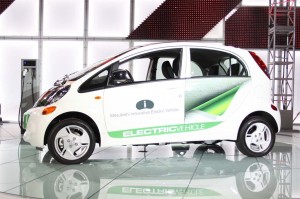
New California rules would put as many as 1.4 million zero-emission vehicles, like this Mitsubishi battery car, on the road.
The California Air Resources Board has released a new set of policies aimed at cutting vehicle pollution, guarantee consumer access to clean fuels and “foster” the development of zero-emission car technology. The major changes in policies will apply to new vehicles sold through 2025.
The new plans includes the most significant changes to the Zero Emissions Vehicles (ZEV) program in its 20-year history—requiring battery, fuel cell, and plug-in hybrid electric vehicles to account for 1.4 million new vehicle sales in the state between 2018 and 2025,pushing carmakers to increase the introduction of vehicles with alternative powertrain technology. The rules are certain to prove controversial.
The Clean Fuels Outlet (CFO) rules would require oil companies to install hydrogen refueling stations as automakers ramp up sales of fuel cell vehicles, ensuring consumers have access to fuel for these vehicles. The CFO also requires California to study infrastructure needs for vehicles that recharge from the electric grid. By 2025, California’s plan calls for a 75% reduction in smog-forming emissions from new cars and light truck tailpipes, the near elimination of evaporative emissions, and a reduction in toxic particulate matter.
Finally, California is also releasing global warming standards for vehicles built between 2017 and 2025 that require a reduction in a vehicle’s emissions to 166 grams per mile— about half of current levels and a 34% reduction from 2016 requirements. These new global warming standards represent a common effort by CARB and the U.S. Environmental Protection Agency to establish a single set of global warming pollution and fuel efficiency requirements for automakers.
The Air Resources Board will consider adoption of its own clean car regulations at its January board hearing in Los Angeles. The board’s position is if federal global warming pollution standards remain on course, it will accept the federal standards as an alternative to its own proposals. California will still, however, maintain its separate vehicle smog, particulate, ZEV and CFO requirements.
“California has led the nation and the world in protecting public health with clean car standards for more than 50 years,” said David Friedman, deputy director of the Union of Concerned Scientists’ (UCS) Clean Vehicles program. “California’s comprehensive program will continue that legacy by driving innovation in automotive emissions technology for the next 14 years and setting the pace of development for the next 40.”
CARB estimates the advanced clean car program would save Californians $22 billion through 2025. In 2025 the program would create 21,000 new jobs across the state as consumers spend less money on gasoline and shift that money to more productive parts of the economy.
Individual consumers would save $4,000 over the life of the typical car sold in 2025, even after paying for clean car technology. The added cost of the technology improvements would be fully recovered from fuel savings within the first 3 years. Consumers who take out a typical new car loan would see savings in the first month they own their car because fuel savings would more than offset their increased loan payments, according to CARV.
On top of all of these benefits, the program would significantly reduce smog-forming pollution and cut global warming emissions by 52 million metric tons between 2018 and 2025.
“These proposals will clean the air while keeping more money in Californians’ pockets,” said Friedman. “There are many problems linked to our oil dependence, and this plan will help ensure engineers in the auto and oil industries are working to help solve those problems rather than extend them.”
